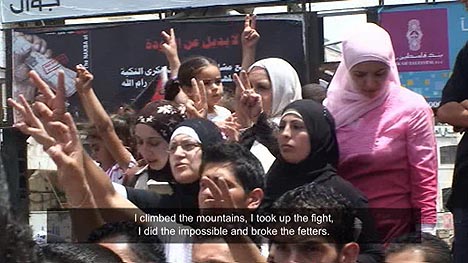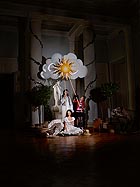
translated and summarized by: Liz Wollner-Grandville,
English summary October 5 - 11
Camera Austria: Artur Zmijewski – “Democracies” and other works
Audio and visual Kaleidoscope
Artur Zmijewski’s current series of videos titled “Democracies” (2007 – 09) comprises 20 videos showing numerous, and very diverse, topics such as protests in the occupied territories of the West Bank, political activists in Poland, marches commemorating the Labour Day in Germany, fans watching the live-broadcast of the football match Germany vs. Turkey, as well as Jörg Haider’s funeral ceremonies in Vienna and Klagenfurt. Thanks to technology, the videos can be viewed on flatscreen monitors, which are elegantly mounted alongside the walls of the show room conveying the atmosphere of a picture gallery.
The sound of the installation forms another, completely independent level. The noises of the videos merge to an entirety and the individual videos evolve into one piece of work, which – polyphone or cacophonous, depending on one’s perception - reflects the sound of the street. This is where the contrast to the second work, “Selected Works” (2006/07), becomes obvious, which is dominated by complete silence. The title itself is a play with the actual meaning of the words and the content of the video. It shows a variety of 24-hour portraits of workers, presenting a selection of the artist’s work, but simultaneously a selection of work, which is being accomplished by human beings on this planet.
The excitement of this “autumn”-compliant exhibition is found in the commonality of the artistic approach and the contrariness of sound in both works.
By Nora Theiss
Camera Austria
8020 Graz, Kunsthaus Graz, Lendkai 1, until 17.01.10
www.camera-austria.at
Schloss Esterházy: Phenomenon Haydn and Haydn Explosive
Diversely attractive
“My language is understood throughout the entire world”, the composer Joseph Haydn once said. Both exhibitions: “Phenomenon Haydn” and “Haydn Explosive”, marking the 200th anniversary of the composer’s death with a both multifaceted and unique appreciation of the artist’s work at the Esterházy Palace in Eisenstadt. “Back to the past. Into the contemporary” describes the first impression of the exhibitions.
Throughout “Haydn Explosive” one encounters the artist, who reflects on the development of art with a historical burning glass. Franz West’s “Paukenschlag” (beat of the drum) flanks the walls of the palace’s Sala Terrana (Italian for ‘ground floor saloon) with paintings of historically relevant personalities. In her installation “Guernica”, Gelitin deals with the upside-down world in the House of Moods. Haydn’s creations were often sneered at and considered to be entertainment for the higher and decadent society. “Guernica” questions this in a cunning and subtle way. Günter Brus’s etching “Stillstand der Dynamik” (standstill of dynamics) represents the social circumstances – following the motto: “leave everything as it is.”
“Phenomenon Haydn” devotes itself to the private life and work of the virtuoso. The rooms, venues for the personal representation of his clothing, the notes, instruments and furniture are in the centre of the classically curated exhibition. This ambience is accentuated by Carl Schütz’s copper engravings, Jakob Phillip Hackert’s etchings, and by Paul Contantijn La Fargue’s painting “Zwei Ansichten von Leiden” (two aspects of suffering) and by a golden centrepiece resembling an ostrich.
The key moment of both presentations lies in their adjustment of the chronological sequence. One can see that the person Haydn “functions” just as well today in the exhibition of the Esterházy Palace as it did the day before yesterday.
By Alexander Lass
Schloss Esterházy
7000 Eisenstadt, until 11.11.09
www.schloss-esterhazy.at
Istanbul Biennial: Branch Beriköy Rum Okulu
In the school of social studies
The members of the Croatian group of curators, WHW, Ivet Curlin, Ana Dvic, Natasa Ilic and Sabina Sabolovic, designed the Istanbul Biennial outposts in a decidedly functional way with only a few drops of irony or ease. The displayed works and installations are linked to different forms of documentations, thereby bringing diverse visual strategies into play.
In the closed down school building Feriköy Rum Okulu in the northern district of Sisli, close to a throughway, where humans and cars pass each other in slow motion, this culminates in approaches with methods of cartography. Remarkable: the room in which works by the group decolonizing.ps, led by the Israeli artist Eyal Weizmann, are presented. The military limitations imposed on the Palestinian’s living space are the central theme displayed in the large-format, heavy books by means of photographs, drawings as well as maps, projections, and a video. By way of newspaper clippings and organization charts transposed into chalk drawings on blackboards, Lado Darakhvelidze describes the current transformation of political structures in Georgia in view of the network of international economic relations.
The setting in a former school building constructs a didactic monotonous staging, which is only broken up through the slide projections by the Polish duo Kwie Kulik (Przemyslaw Kwiek, Zofia Kulik) created in the 70’s. In a series of slides, Kwie Kulik’s son is shown over a range of years as a child thrown into existence and photographed in trivial household surroundings.
This actionist irritation points to the attempt of the curators to constitute a general context by way of a linguistic operation. Igor Grubic (Hungary) also refers to geographical and state-driven frameworks when he focuses on the violent assaults on the first Gay Pride celebrations in the newly formed states of Serbia and Croatia. By including the gender topic, it then also becomes plausible why works of the Body Art artist Michel Journiac are displayed.
All in all, there is little play; rather the recollection of the social realities of the outside world. Here, in a former school building in the immediate periphery of a compact district, bordering on a near standstill. Irritating? Maybe. Since the Istanbul Biennial almost appears with a wagging finger. But only almost. Because, seen from a different angle, the exhibition keeps its seriousness, without fraying.
By Roland Schöny
Istanbul Biennial
Istanbul, until 08.11.09
www.iksv.org/bienal11
Galerie Lang Wien: Othmar Zechyr – Drawings from three decades
Of erratic blocks and other compressions
The compression of lines and streaks – mainly made with a China ink quill -, the play with planes and the imaginary space on paper are the characteristics of these works.
They also prove how important it is for the artist to take up space, fill out space, and to be perceived; delicately and quickly set lines show natural monuments – heaps or chunks, as well as fantastic architectures. His drawing always include grown and never constructed forms and figures, and - similar to the way these objects seem to have developed out of the act of drawing - his entire artistic creativity seems to have developed out of his life. His works clearly show that he did not lead a particularly fulfilled and happy life, yet they also always include a playful lightness, especially regarding the style in which he sets the lines.
Zechyr’s Upper Austrian origin and the rugged beauty of the region as well as his “career” in various approved schools coined the artist, all of this becomes apparent in the China ink drawing “Vorchdorf”. The work conveys the humid coolness of the autumn, after the fields have been ploughed. His works speak a rugged language; one that takes time getting used to, and one that only someone with his biography and origin can have.
That his works are convincing even 13 years after his death lets one hope, that they will find their place in art history and will not fall into oblivion again.
By Wolfgang Pichler
Galerie Lang Wien
1010 Vienna, Seilerstätte 16, until 15.11.09
www.glw.at
Mehr Texte von translated and summarized by: Liz Wollner-Grandville


 Teilen
Teilen




